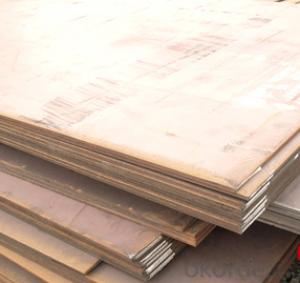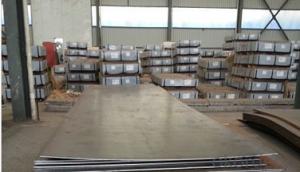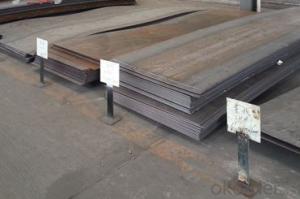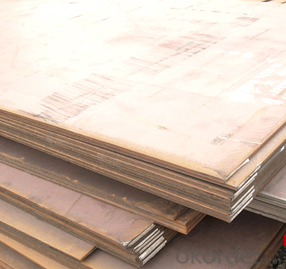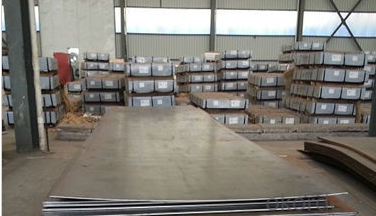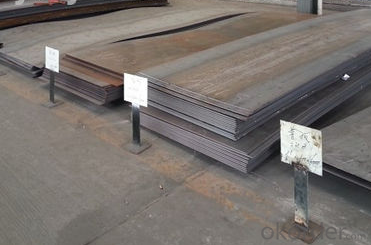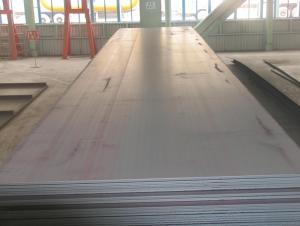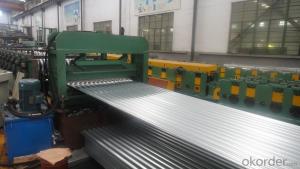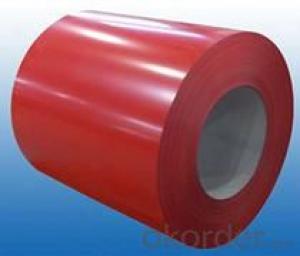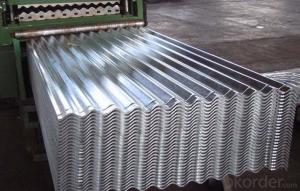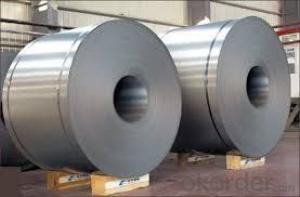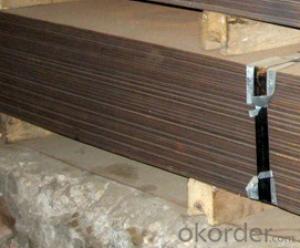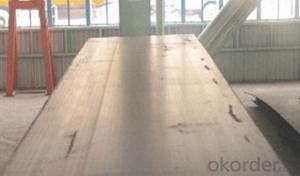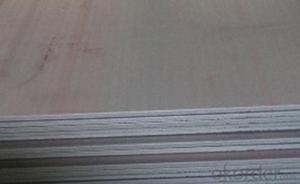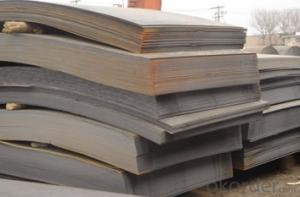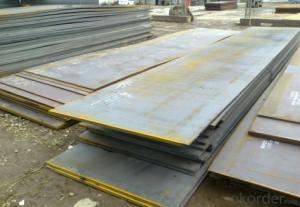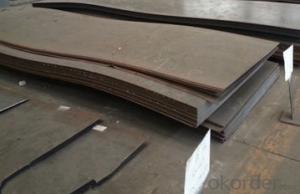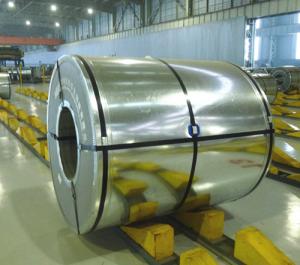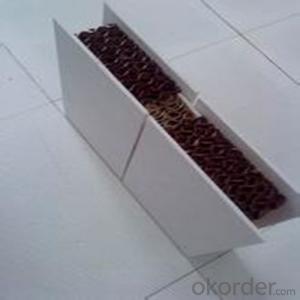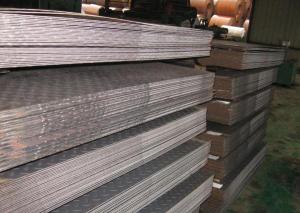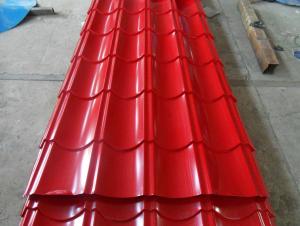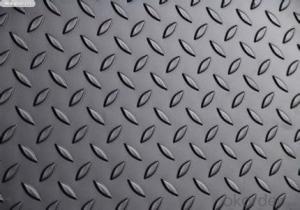Hot Rolled Carbon Steel Sheet SS400 CNBM
- Loading Port:
- Qingdao
- Payment Terms:
- TT OR LC
- Min Order Qty:
- 10 pc
- Supply Capability:
- 30 pc/month
OKorder Service Pledge
Quality Product, Order Online Tracking, Timely Delivery
OKorder Financial Service
Credit Rating, Credit Services, Credit Purchasing
You Might Also Like
Quick Details
| Standard: | AISI, ASTM, DIN, GB, JIS | Grade: | A572,A573,A633,A678,A709,A710,G3101,G3136,etc | Thickness: | 1mm-200mm |
| Brand Name: | SHOU GANG GROUP, AN STEEL | Model Number: | Q235 | ||
| Type: | Steel Plate | Technique: | Hot Rolled | Surface Treatment: | Coated |
| Application: | widely | Special Use: | High-strength Steel Plate | Width: | 1000mm-3000mm |
| Length: | 1000mm-12000mm | Price Term: | FOB CIF CFR |
Packaging & Delivery
| Packaging Details: | standard seaworthy export packing or as the request of customers |
| Delivery Detail: | 10 days after deposit or according to customers' quantity |
Specifications
hot rolled carbon steel sheet
1.Thickness:1mm-200mm
2.Length:1000mm-12000mm
3.Width:1000mm-2000mm
hot rolled carbon steel sheet
| Product | HR steel plate prices carbon steel plate prices per kg |
| MOQ | 25 ton |
| Thickness | 1mm-200mm |
| Width | 1000mm-3000mm |
| Length | 1000mm-12000mm |
| Application | widely |
| Standard | AISI,ASTM,BS,DIN,JIS,GB,etc |
| Grade | A572,A573,A633,A678,A709,A710,G3101,G3136,etc |
| Tpye | Steel plate |
| Surfacing | Coated |
| Productive Technology | Hot Rolled & Cold Rolled |
| Port | |
| Payment Terms | L/C,T/T,Western Union,MoneyGram |
| Product Ability | 5000 tons per month |
| Delivery | 10 days after deposit or according to customers' quantity |
| Packing | standard seaworthy export packing or as the request of customers |
- Q: How are steel sheets protected during cutting and fabrication?
- To ensure the quality and prevent damage, various methods are employed to protect steel sheets during cutting and fabrication. One widely used approach is galvanizing, which entails applying a zinc coating to the surface of the steel sheet. This zinc coating acts as a barrier against corrosion and other forms of harm, making it particularly effective in outdoor settings where steel sheets are exposed to moisture and harsh elements. Another technique for safeguarding steel sheets during cutting and fabrication involves the use of lubricants or coolants. These substances are applied to both the cutting tools and the steel sheet itself to reduce friction and minimize heat generation. By doing so, lubricants and coolants help prevent warping and distortion of the steel sheet during the cutting and fabrication process. Moreover, protective films or tapes are often utilized during the fabrication of steel sheets. These films or tapes shield the sheets from scratches, abrasions, and other physical damage that may occur during handling or transportation. In addition to these methods, proper handling and storage practices play a crucial role in protecting steel sheets during cutting and fabrication. It is essential to store the sheets in a controlled environment to prevent exposure to damaging elements such as moisture and extreme temperatures. Additionally, they should be handled with care to avoid impacts or bending that could compromise their structural integrity. In summary, steel sheets are protected during cutting and fabrication through the combined use of surface coatings, lubricants or coolants, protective films or tapes, and proper handling and storage practices. These measures ensure the quality and durability of the sheets, allowing them to maintain their integrity throughout the fabrication process and beyond.
- Q: What is the maximum temperature resistance of steel sheets?
- The maximum temperature resistance of steel sheets varies depending on the specific type of steel and its composition. However, in general, stainless steel has good heat resistance and can withstand temperatures up to about 1200 degrees Celsius (2200 degrees Fahrenheit) without losing its strength or structural integrity. High carbon steels, on the other hand, can handle temperatures up to about 900 degrees Celsius (1650 degrees Fahrenheit) before they start to lose their mechanical properties. It is important to note that these temperature limits are approximate and may vary depending on factors such as the duration of exposure, the presence of other elements or impurities in the steel, and the specific application in which the steel sheets are being used. Therefore, it is always advisable to consult the manufacturer's specifications or conduct further research to determine the exact maximum temperature resistance of a particular type of steel sheet.
- Q: How are steel sheets tested for quality and performance?
- Steel sheets are tested for quality and performance through various methods such as mechanical testing, chemical analysis, and visual inspection. Mechanical testing involves subjecting the steel sheets to stress, tension, and hardness tests to determine their strength and durability. Chemical analysis is conducted to assess the composition and purity of the steel, ensuring it meets the required standards. Visual inspection checks for any surface defects, such as cracks, scratches, or unevenness in the steel sheets. These comprehensive testing methods ensure that steel sheets meet the desired quality and performance criteria.
- Q: What is the average thermal conductivity of steel sheets?
- The average thermal conductivity of steel sheets typically ranges from 15 to 50 Watts per meter Kelvin (W/m·K).
- Q: Are steel sheets resistant to impact and vibration?
- Yes, steel sheets are generally resistant to both impact and vibration due to their high tensile strength and durability.
- Q: What are the different thicknesses available for steel sheets?
- The thicknesses available for steel sheets vary and can range from as thin as 0.4mm to as thick as 25mm, depending on the specific requirements and applications.
- Q: Can steel sheets be used for automotive exhaust systems?
- Yes, steel sheets can be used for automotive exhaust systems. Steel is a commonly used material in the construction of exhaust systems due to its durability, heat resistance, and cost-effectiveness.
- Q: What is the difference between galvanized and non-galvanized steel sheets?
- The main difference between galvanized and non-galvanized steel sheets is the presence of a protective zinc coating on the galvanized sheets. This coating helps to prevent corrosion and rusting, making galvanized steel sheets more durable and long-lasting compared to non-galvanized ones.
- Q: How do steel sheets compare to stainless steel sheets in terms of corrosion resistance?
- Steel sheets and stainless steel sheets differ significantly in terms of corrosion resistance. While steel sheets are susceptible to rust and corrosion when exposed to moisture and certain environmental conditions, stainless steel sheets are specifically designed to resist corrosion. Stainless steel contains a higher percentage of chromium, which forms a protective layer on its surface, preventing rust and corrosion. Therefore, stainless steel sheets offer superior corrosion resistance compared to regular steel sheets.
- Q: How do steel sheets perform in terms of thermal expansion?
- Steel sheets have a relatively low coefficient of thermal expansion, meaning they expand and contract minimally when exposed to temperature changes. This property makes them suitable for various applications where dimensional stability is crucial, as they are less likely to warp or deform due to thermal expansion.
Send your message to us
Hot Rolled Carbon Steel Sheet SS400 CNBM
- Loading Port:
- Qingdao
- Payment Terms:
- TT OR LC
- Min Order Qty:
- 10 pc
- Supply Capability:
- 30 pc/month
OKorder Service Pledge
Quality Product, Order Online Tracking, Timely Delivery
OKorder Financial Service
Credit Rating, Credit Services, Credit Purchasing
Similar products
Hot products
Hot Searches
Related keywords
